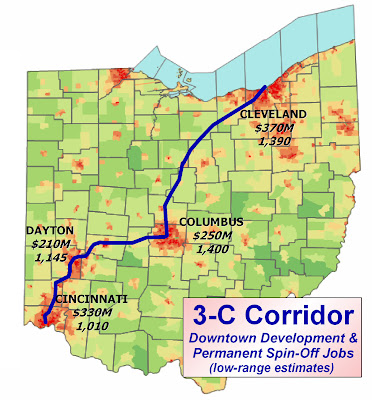When discussing transit issues with people who oppose transit you often hear the statement that they’re not against transit necessarily, they just don’t like the proposed plan that you’re discussing. It’s odd, because there never seems to be a plan that these people like.
In 2002, the regional transit plan was too big for COAST’s liking, while the current streetcar proposal is too small. COAST also argues that the proposed modern streetcar (video) is in fact outdated technology since two other American cities currently have it (Portland, Seattle). After hearing these arguments I have repeatedly asked for an alternative proposal of something COAST would support.
Finally Mark Miller let me in on the “latest technology” for mass transit – low-level buses that have an overhead electric power source. The response seemed shocking given the discussion was surrounding a Midwest Regional Rail plan that Cincinnati could be left off. Also shocking was the identification of an electric-powered bus as being the “latest technology” in transit.
 The Ohio Hub portion of the larger Midwest Regional Rail Plan that would connect the Midwest’s population and job centers with high-speed rail service. COAST’s Anti-Passenger Rail Amendment would prevent Cincinnati from investing in “passenger rail transportation” without first getting voter approval – a process that would leave Cincinnati out of the funding loop and off of the regional rail network.
The Ohio Hub portion of the larger Midwest Regional Rail Plan that would connect the Midwest’s population and job centers with high-speed rail service. COAST’s Anti-Passenger Rail Amendment would prevent Cincinnati from investing in “passenger rail transportation” without first getting voter approval – a process that would leave Cincinnati out of the funding loop and off of the regional rail network.Miller did not identify MagLev’s 300+ mph Transrapid train (video) that utilizes magnetic propulsion to avoid friction resistance and attain higher speeds, or the enhanced MagLev systems that could travel within a vacuum tube (air-less) thus avoiding the sonic boom that would come with speeds in five to six times faster than the speed of sound. A “vactrain” would be able to travel at speeds of 4,000-5,000mph at-grade and in normal conditions due to the lack of air resistance. Such a system could take passengers from New York City to London, Brussels, or Paris in about an hour, and would cost less than what the U.S. Government has recently spent to bail out our financial sector.
COAST likes to suggest that an electric-powered bus would some how serve as an alternative to a modern streetcar system. This either/or proposition is based on a false premise, that either buses or modern streetcars should be pursued. In many cities with robust transit choices you will see modern streetcars (aka trams), heavy-grade rail like subways, electric-powered buses and much more.
 Buses powered by overhead electric wires run all throughout Athens, Greece. Here one of those buses is running next to a modern tram at a station near Syntagma Square.
Buses powered by overhead electric wires run all throughout Athens, Greece. Here one of those buses is running next to a modern tram at a station near Syntagma Square.Miller went on to clarify what he was describing with an example from Lyon, France. These buses with modern designs are sleek and are powered by electricity like modern streetcar systems, but that is where the similarities end. They still have lower capacities (unless COAST is also advocating for articulated buses), have higher maintenance costs/shorter life spans, and should be used differently in an overall transportation system hierarchy.
Modern streetcar systems aren’t pursued because they somehow represent a fascination for trains and their modern designs. Modern streetcar systems are pursued because they are the best localized transit network for cities. They run smoothly, are ADA compliant, move people very efficiently, they’re durable, produce no pollution in the direct surroundings, and they’re proven to work.
I think Cincinnati is a world-class city, and that it deserves the best. And if COAST wants to advocate for a retooled bus system that operates with an overhead electric power source then great. I will be right there to help them push for an improved bus system, but for some reason I don’t think that COAST will be so jazzed about spending money on articulated buses, real-time arrival GPS systems, overhead electric power feeds, new bus rolling stock that can utilize said power source, or dedicated right-of-way for these new and improved buses.





